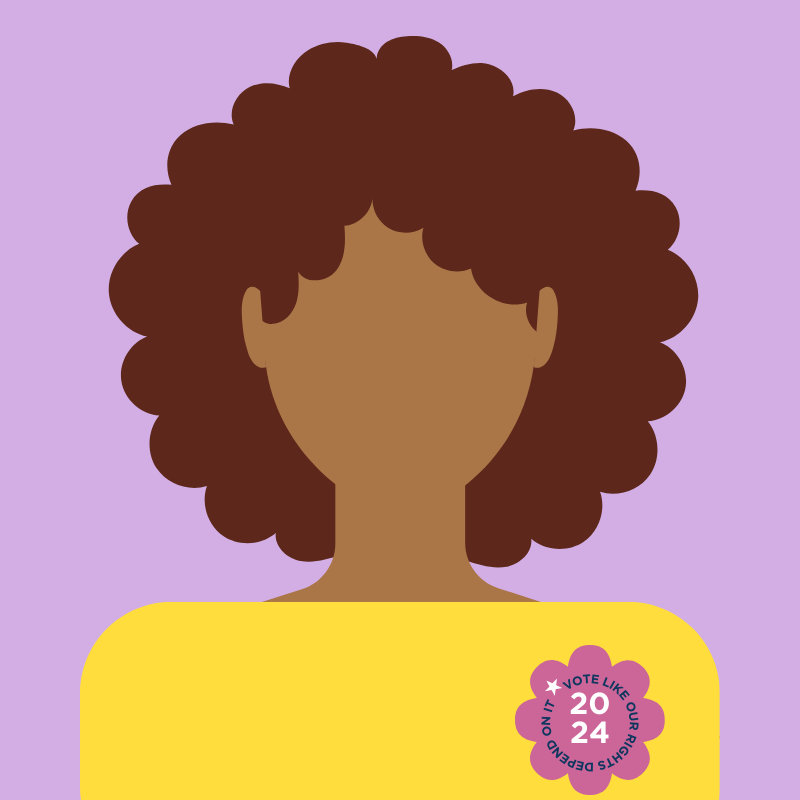
Voting is not only a fundamental right, it is a responsibility. Every individual voter has the opportunity to have their say about the future of the country and of the world. But deciding who to vote for can be challenging! To help you make that decision, we created a voter guide. You’ll find this and other helpful resources throughout this page so scroll on, and vote like our rights depend on it!
-
If you are reading this guide, you probably share Jewish Women International’s vision for the future: a world, free of violence and inequity, where all women and girls thrive. At JWI, we will not tell you for whom to vote. Who you vote for is a deeply personal decision - one that only you can make. However, we can help you ask the right questions about candidates to determine whether they also share this vision for the future.
This voting guide is not exhaustive. Instead, if focuses on four key issues critical to our vision: reproductive rights, support for victims and survivors of domestic violence and sexual assault, gun violence prevention, and women’s economic empowerment. These are issues that must be addressed by individuals running for public office at the federal, state, and local level.
To determine a candidate’s position on these issues, look at their policy positions on their websites. If a candidate is an incumbent, look at their voting record and also at legislation they have introduced or sponsored. If their platform does not address one or more of these key issues, ask them! You can ask them by phone or email, but it might be even more impactful to ask them publicly at a constituent townhall meeting, at a campaign event, or on social media, so their position becomes part of the public record.
-
While the right to make decisions about our own bodies is a fundamental human right, it is not a legal right everywhere in the United States. State and local governments are restricting people’s legal rights to make decisions about their own reproduction, limiting or entirely denying access to safe, legal abortions. No person should be forced to carry a pregnancy to term against their will, and people of all ages and genders should have access to the full range of contraception options. And people who want to start a family but are struggling with fertility should have access to a variety of treatment options, including in vitro fertilization.
What to look for
Support for policies protecting access to abortion throughout the duration of a pregnancy
Support for policies to publicly fund family planning clinics, including those offering abortion services
Support for access to contraception for teens without parental involvement
Support for access to medication abortion via mail, prescribed by a pharmacist, and via telemedicine
Opposition to abortion bans, waiting periods, mandatory ultrasounds, limits on certain types of abortion, ‘admitting privilege’ requirements for abortion providers, and privaterights of action that allow individuals to bring civil suits against people who access or who provide abortions
Opposition to public funding for ‘crisis counseling centers,’ which try to talk people out of getting abortions
Red flags
‘It should be left up to the states’
‘Parents should decide’ about teen access to contraception
Support for restrictions on abortions before 20 weeks at the earliest
Support for waiting periods, mandatory ultrasounds or counseling, or other tactics designed to dissuade people from accessing abortions
Support for requirements related to disposing of aborted materials that differ from disposing of other biomedical materials
1 When we say “women and girls,” we mean everyone who experiences the world as female– of every race, culture, ability, gender identity, and sexual orientation.
-
According to the Centers for Disease Control and Prevention, 41% of women in the United States experience intimate partner violence with ‘IPV impact in their lifetime,’ and 27% of women experience attempted or completed rape in their lifetime. Domestic violence and sexual assault require a coordinated community response to protect survivors, to prevent future violence, to help survivors heal, and to hold offenders accountable. Survivors are the experts in their own experiences, and we believe survivors and trust them to make decisions for themselves.
What to look for
Support for robust government funding for holistic victim services, including domestic violence shelters, rape crisis centers, and legal services
Support for domestic violence and sexual assault prevention programs, including ongoing healthy relationship education for K-12 students
Support for firearm restrictions for adjudicated abusers and stalkers (see gun violence prevention section) and surrender and removal protocols
Support for economic supports for victims and survivors, including direct cash assistance
Support for housing supports for victims and survivors
Support for culturally specific victim services, services for underserved victims, and victim services by and for the communities they serve
Support for lifting caps on visas for immigrant survivors and for granting work authorization while survivors are waiting for their visas
Support for restorative justice and survivor-led accountability
Support for child custody for protective parents
Opposition to punitive measures to force victims to testify or punish victims for the violence perpetrated against themRecognition of Hamas’s perpetration of sexual violence against people in Israel on October 7, 2023 and sexual violence against hostages
Support for the release of hostages being held in Gaza
Support for initiatives that center the leadership and experiences of women in conflict zones in creating peace and stability
Red flags
Shifting burden of funding for victim services to philanthropy or saying the government cannot afford it
Limiting access to victim services based on sexual orientation or gender-identity or claims that ‘biological males’ are attempting to access shelter to harm ‘real women’
Support for arming victims
Claims that domestic violence protective orders violate due process
Minimization of domestic violence or sexual assault
Victim blaming
Misogynistic or sexualized language
Support for policies that hold victims accountable for perpetrator actions, including in child custody proceedings
Denying Hamas’s sexual violence on and after October 7, 2023
-
Homicide, primarily committed with firearms, is the leading cause of death for pregnant and postpartum women in the United States - not obstetric causes. Gun violence is also the leading cause of death for children and youth. Most women who are murdered in the United States are murdered by intimate partners, and most of these homicides are committed using firearms. Women in the United States are 21 times more likely to be murdered with a firearm than are women in other industrialized nations. Community violence, firearm suicide, school shootings, accidental shootings, and mass shootings are all exacerbated by weak gun laws and easy access to firearms. All of the research shows that gun ownership increases, not decreases, a person’s risk of homicide or suicide.
What to look for
Support for policies to disarm domestic abusers and stalkers, including policies prohibiting firearm possession for individuals subject to ex parte and final domestic violence protective orders (including dating partners), policies prohibiting firearm possession for people convicted of a misdemeanor crime of domestic violence (including dating partners) or stalking, and policies requiring prohibited people to relinquish their existing firearms
Support for universal background checks
Support for policies requiring safe storage of firearms
Support for an assault weapons ban
Support for funding for community violence prevention intervention programs
Support for extreme risk orders (sometimes known as ‘red flag laws’)
Support for holding gun manufacturers and sellers accountable for wrongdoing
Support for policies prohibiting people convicted of a violent misdemeanor crime or of a misdemeanor hate crime from possessing firearms
Support for permit-to-purchase laws and concealed carry permit laws
Red flags
Support for arming women or victims of domestic or sexual violence
Claims that gun access by law-abiding citizens decreases crime
Claims that the 2nd Amendment precludes regulation of firearms and firearm access
Blaming gun violence on mental illness
‘Guns don’t kill people, people kill people’ or ‘the best way to stop a bad guy with a gun is a good guy with a gun’
Support for ‘stand your ground’ laws or permitless carry laws
Support for ‘concealed carry reciprocity’ at the federal or state level
-
Women working full-time in the United States are paid $0.84 for every $1.00 paid to men, and women of color are paid even less. Compared to other developed nations, women aged 25-54 are underrepresented in the workforce–but women over 65 (retirement age) are overrepresented. In many families, women are expected to both work full-time and shoulder the bulk of caregiving responsibilities, including caregiving for children and for older adults. Women face discrimination in hiring, in promotion, and in compensation. And despite requiring specialized knowledge and skills, jobs typically associated with women such as teaching and nursing are undervalued and undercompensated.
What to look for
Support for paid sick and safe leave for all employees
Support for paid vacation for all employees
Support for paid parental leave for all employees
Support for increasing the minimum wage to a living wage, including for tipped workers and workers with disabilities
Support for increasing compensation for teachers, nurses, and individuals employed in the care economy
Support for universal access to comprehensive healthcare
Support for job training programs, with an emphasis on increasing women’s participation in well-paying professions that do not require a college education
Support for free period products in schools to ensure education is not disrupted by menstruation
Support for access to free or low-cost high-quality childcare
Support for the Paycheck Fairness Act
Support for funding for the Equal Employment Opportunity Commission and state and local commissions to enforce laws prohibiting employment discrimination
Support for collective bargaining and the right for workers to organize
Support for access to supportive services for older adults
Support for universal preschool and public funding for higher education
Support for laws requiring job posts to include salary ranges and benefits, banning the use of prior salary history in setting pay, and banning employers from prohibiting employees from discussing salaries with each other
Support for a strong social safety net
Red flags
Union busting and so-called “right to work” legislation, which seeks to undermine collective bargaining
Emphasis on “personal responsibility,” which blames low income people for structural inequality
Support for policies that limit access to safety net programs, including work requirements, funding cuts, transforming entitlement programs into block grants, and limiting access by citizen children with non-citizen parents
Claims that tax cuts for corporations and the wealthy create jobs
-
By electing candidates who support these policy positions, we can contribute to a society that prioritizes safety, equality, and reproductive freedom. Remember to research candidates' stances on these issues and vote for those who align with these values. Your vote has the power to shape a future where all individuals can live free from violence, with the autonomy to make choices about their health and well-being.
Vote for a safer, more inclusive future.
Voting FAQ
How do I register to vote?
Click below and select your state or territory for information on how to get started!
What do I need to bring with me to vote?
Each state has different voter ID requirements as well as special ID rules for some first time voters.
How do I find my polling location?
Polling locations are based on your county. Click the button below to easily find your voting precinct and polling location.

Upcoming Events
Check back here upcoming events!
Merchandise
Coming soon!





